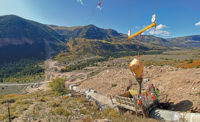Water rights in the western United States have created piles of legislation, court battles, even gun fights. For managers of the Central Utah Water Conservancy District (CUWCD), holding onto long-established water rights in the second-driest state in the country meant replacing a historic hydroelectric generating plant on the Provo River.
“This is a water-rights project first and a power-generation project second,” says K. C. Shaw, chief engineer for CUWCD. The district recently completed a $42-million replacement of the 111-year-old Olmsted hydroelectric plant and its conveyance systems.
CUWCD manages water storage and delivery systems as part of the Central Utah Project (operating under the oversight of the U.S. Interior Dept.). CUP delivers water from the mountains and remote parts of the state for use in urban and agricultural areas.
History-Making Plant
The run-of-the-river Olmsted powerplant, whose turbines operate only when downstream users require water—along with its associated water rights—were established in 1897 by Lucien Nunn, a mine operator and early supporter of alternating-current electrical systems.
He built a hydroelectric plant on the Provo River and began transmitting power 32 miles away to the now-defunct mining town of Mercur. It was among the first high-voltage, long-distance AC power-transmission systems in the world and demonstrated the feasibility of the concept.
Nunn soon moved the plant to the mouth of the canyon to take advantage of the higher water velocity there. Some of the plant’s new conveyance systems were designed by Fay Devaux Olmsted, who died shortly before it opened in 1904. Nunn named the facility in his honor.
Over time, the plant and its associated water rights passed through several owners until a 1990 settlement with electrical utility Pacific Corp., which made the plant part of the CUP. In previous decades, CUP had acquired and built systems that also supplied water to the plant, but its continued operation is an essential part of the agreement to maintain water rights, Shaw says.
“We supply five of the largest drinking-water systems in the state off this system, and it includes water used by this powerplant,” Shaw says. “If we want to be able to continue to store and deliver that water, we need to maintain this plant.”
In keeping with the agreement, the plant continued operating and generating power until September 2015, when the agreement expired. By that time, work on a replacement plant was underway.
More Than a Powerplant
In 2010 the CUP contracted with CH2M (now Jacobs) to evaluate the existing Olmsted power facilities. They included the powerplant; three 48-in. and one 72-in. penstocks connected to a hillside pressure box; an 850-ft-long, unlined rock tunnel; as well as associated conveyance systems from a 10-million-gallon bifurcation reservoir and a diversion dam six miles up the Provo River.
“We came into this looking at what could be done with equipment that was already here and see if we could rehabilitate the original plant,” says Adam Murdock, principal project manager with the western region offices of Jacobs. “We found the existing plant could be awkward to operate with the systems that were in place. The existing turbines were cavitated and at the end of their useful lives, so to get another 75 to 100 years out of this, it just made sense to build a new plant.”
Other elements of the conveyance system needed to be replaced to improve efficiency and align with the new powerplant. Murdock said the first challenge was to find generating equipment that could operate with wide variations in water flow. Designers developed a plant run by two Francis-type hydraulic turbines with synchronous generators. They are manufactured by Andritz Hydro, based in France.
“We have two different generators. The smaller one can handle 30 to 120 cfs and the large one can handle 84 to 300 cfs, and then we have two micro-hydro units that can operate at 19 cfs,” Murdock says. “We can generate 11.5 megawatts at 12.47 kilovolts."
Power from the plant will be transmitted to the Provo Power utility, then distributed by the Utah Municipal Power Agency.
The contract to build the new plant and improve conveyance systems was awarded to the Utah office of Ames Construction. Ames project manager Brandon Evans says the team began with site preparations in September 2016.
“With the powerhouse located right next to the Provo River, we did some groundwater investigations and found we needed to do dewatering,” Evans says. “We drilled 15 dewatering wells and pumped and filtered the water before it was discharged into the tailrace that empties into the Provo River.”
Ames’s crews also demolished the pressure box that adhered to the sheer canyon wall for decades, as well as penstocks that ran downhill from it to feed the original plant.
“Upstream, we rehabilitated about 1,600 feet of 102-inch pipe, cleaning out old epoxy and putting in new mortar,” Evans says.
He says that engineers decided to take advantage of pressure from the reservoir and placed pipe in the 850-ft-long rock tunnel, where water had previously flowed uncontained.
“Getting the pipe in there was one of the bigger challenges,” Evans says.
Crews from Ames installed steel rails in the tunnel and sections of 80-in. pipe were placed on a carrier and pushed into the tunnel using a skid-steer. After the pipe was installed, they built a bulkhead at the tunnel opening and injected cellular grout into the space around the pipe.
Crews demolished and replaced the four original penstock pipes that ran downhill to the plant site with a single 84-in. pipe to the new powerplant.
According to Murdock and Evans, another significant challenge was coordinating with manufacturers of the generating equipment, most of whom are based in Europe. Specifications for the equipment were underway while Jacobs was designing the plant and finalizing locations for the generators and pipes inside it.
“The tolerances for placement of the turbines and generators were very tight,” Evans says. “We left the roof off the plant until we could get the equipment. We had some 300-ton cranes to lift and set them on the concrete bases; they had to be just perfect. Then we had to keep them protected from the weather while we finished the rest of the building.”
The new 40,000-sq-ft Olmsted plant includes control-and-monitoring rooms as well as a meeting room. Built on a sloping 2.6-acre site, the interior height of the power station, from its lowest section to the peak of the roof, is just over 80 ft.
While the early days of the original Olmsted plant required several dozen engineers and maintenance workers to live near it, the new facility can be run with only a few staff. All systems are monitored and operated remotely through an extensive supervisory control and data acquisition (SCADA) system.
The new plant is sited to the east of the original Olmsted plant, which remains on the National Register of Historic Places. The old plant will become a museum, with the original generating equipment and some wiring left in place. Sections of pipe and headgates are on display outside. Other exhibits include artifacts found during excavation, as well as many historic photographs.




